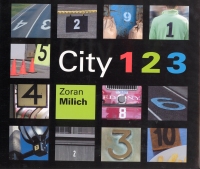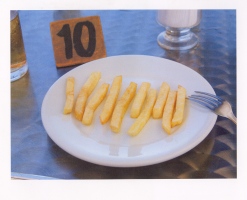| ________________
CM . . .
. Volume XI Number 17 . . . . April 29, 2005
Parents, teachers, teacher-librarians and children's services librarians are likely already aware of Milich's earlier concept books: The City ABC, City Signs and City Colors. As with his previous titles, Milich utilizes photographs taken in urban settings to illustrate the concept being presented. In City 1 2 3, he deals with the numbers from one to 10. Two pairs of facing pages each present a single number, and then Milich uses the third pair of facing pages as a type of review of the numbers up to that point. In the pairs of facing pages dealing with a single number, the left hand pages have the numbers from one to 10 printed in black in a horizontal line with the focal number appearing in red. Below the numbers appears a series of red dots equal to the target number. As well, the appropriate number is printed at the bottom of the page in lower case letters. The photographs which occupy the right hand pages always contain the focal number as well as the appropriate number of objects for counting purposes. For example, "two" has the number 2 appearing on a yellow road sign and two yellow taxis can be seen in the background. For younger readers, being able to count the appropriate number of objects may be challenging in some cases. "Seven" is visually portrayed by seven office towers, but the buildings overlap, and some younger "readers" may not be able to recognize the overlapping buildings as being separate structures. The photograph for the number eight was taken in a fire station, and it shows four sets of fireman's pants and boots in front of a fire truck. Of course, children are to count the legs and boots, but again younger "readers" could misread what is expected of them and "see" only four. Children may also pause before realizing that "three" is represented by the three wheels on the cement mixer truck.
Parents who share this book with their children a number of times can also extend the photographs beyond just "learning" numbers. In addition to the obvious connections to colours, the pictures can be used in other ways. For example, with the "two" picture, children could be asked to indicate what season they believe it to be. (There are no leaves on the trees, but there are also no shed leaves on the ground which has a slight green hue.) The fire truck picture could lead to a conversation about why the firefighters' gear is set out in this way. The illustration for "nine" shows nine large paper bags in front of a blue dumpster, but what's in the bags? Definitely a home purchase, City 1 2 3 should also be acquired by libraries serving preschoolers and kindergarten-aged children. Highly Recommended. Dave Jenkinson teaches courses in children's and adolescent literature in the Faculty of Education, the University of Manitoba.
To comment
on this title or this review, send mail to cm@umanitoba.ca.
Copyright © the Manitoba Library Association. Reproduction for personal
use is permitted only if this copyright notice is maintained. Any
other reproduction is prohibited without permission.
NEXT REVIEW |TABLE OF CONTENTS FOR THIS ISSUE - April 29, 2005. AUTHORS | TITLES | MEDIA REVIEWS | PROFILES | BACK ISSUES | SEARCH | CMARCHIVE | HOME |

 The photographed objects range from the familiar (10 french fries or 5 traffic cones) to the less
familiar (4 sections of a factory wall or 4 subway car doors). In some instances, viewers are
provided with more than one counting opportunity. In addition to the four red subway doors, four
green arrows can be viewed while, along with six yellow toy chickens, a viewer can also see six
wrought iron posts.
The photographed objects range from the familiar (10 french fries or 5 traffic cones) to the less
familiar (4 sections of a factory wall or 4 subway car doors). In some instances, viewers are
provided with more than one counting opportunity. In addition to the four red subway doors, four
green arrows can be viewed while, along with six yellow toy chickens, a viewer can also see six
wrought iron posts.